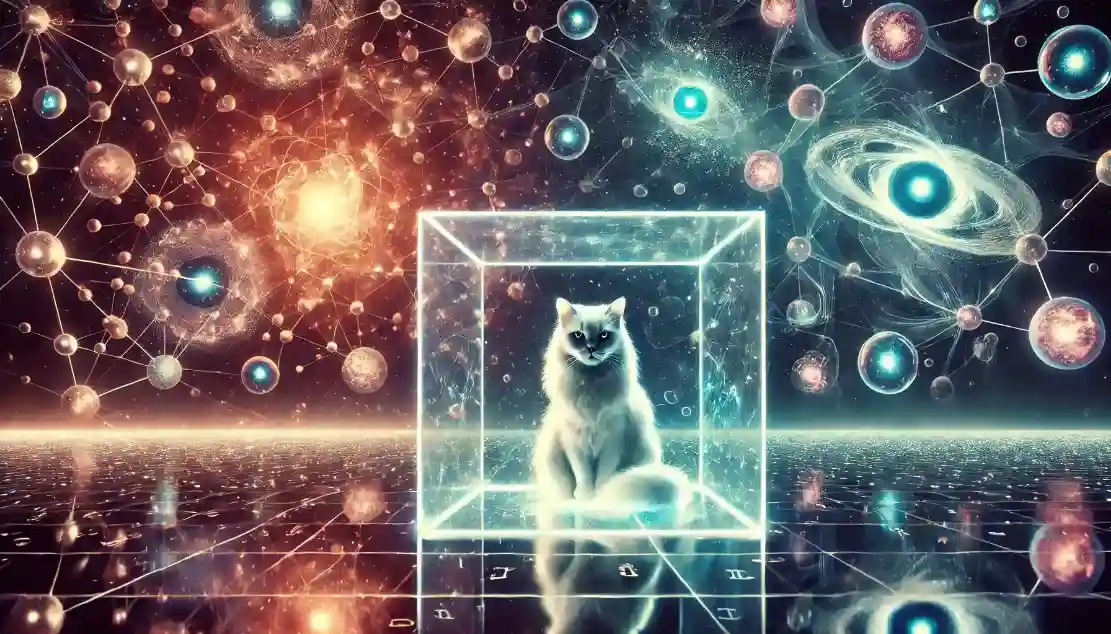Abstract
Ever since Schrödinger thought it up and coined the now-ubiquitous term in 1935, the so-called Schrödinger’s Cat thought experiment has tantalized physicists and philosophers alike for many decades and curious people also with its absurd but thought-provoking picture: a cat that is dead or alive only upon observation, with no predetermined fact about which at all previous time.
Recently, a new theory was proposed to explain this paradox: we live in a multiverse gigantic ensemble of parallel universes where all possible outcomes of any quantum event happen. In this blog post, we’ll dive into this mind-blowing theory, its implications for our understanding of reality, and how it aligns with the fundamental principles of quantum mechanics.
Understanding Schrödinger’s Cat
It is only by revisiting the thought experiment of Schrödinger’s Cat that one can get a clear view of the significance of the new multiverse theory. Schrödinger designed this scenario to depict the peculiarities of quantum mechanics, especially the concept of superposition.
The Thought Experiment
A cat is put in a sealed box with a radioactive atom, a Geiger counter, and a vial of poison. If the atom decays, the poison is released through the Geiger counter, which kills the cat. However, if the atom does not decay, then the cat is not killed. According to quantum mechanics, the cat, in fact, is simultaneously dead and alive until the box is opened to observe the system.
This paradox brings deep questions of how reality itself presents, along with the phenomenon that measurement really portrays. It should be contended that at times the cat lives and is also dead in equal measure. Moreover, whether mere observation changes some state about an observed system?
These debates themselves have culminated in exhaustive research done to find explanations by quantum physicists as well.
The multiverse theory states that the universe splits into other branches for every occurrence in quantum, but a branch always means a certain result. The instance of Schrödinger’s cat was an example whereby, at opening the box, two universes were produced. One of these universes has the cat as alive while the other has it dead. This implies that all the outcomes could exist in other parallel realities while solving the problem of superposition.
Historical Background
It actually finds its root in the many-worlds interpretation of quantum mechanics, which a physicist named Hugh Everett III presented for the very first time way back in 1957. The new interpretation that was developed at that point in time was considered radical, as it assumed that a wave function of a system does not collapse upon observation but persists in all of its branches existing at the same time in each one of their different worlds.
The provided interpretation has consequences on the original Copenhagen interpretation; this suggests that it is the measurement alone that causes the wave function to collapse into one solution.
Basic Principles of Multiverse Theory
All branching universes would emerge from a quantum event because, according to the concept of the multiverse, an infinite number of parallel universes, providing all possible solutions, occur in each of these existing ones.
No Wave Function Collapse: In multiverse theory, the wave function is not collapsed due to observation. Instead, observers entangle with the results; then branching of reality occurs.
Observer Independence: According to multiverse theory, it is the outcome of a quantum event is not controlled by the observer rather it is one of the realities that an observer is experiencing.
Conclusion for Quantum Mechanics
This has also given a solution to the Schrödinger’s Cat paradox, among other far-reaching implications for our understanding of quantum mechanics. It thus challenges the long-held traditional view of a single objective reality and postulates that our view of reality is but one in a sea of possible experiences.
- Observer Effect: The observer effect, which is a part of quantum theory, states that the measurement of the observable actually changes what the system in which it measures exists. With this, according to the theory of the multiverse, measurement merely indicates one particular among many in reality. On a deeper basis, this vision sets the observation and the notion about the observers and their contributions towards quantum.
- Determinism vs Free Will: The multiverse theory raises the question of whether or not it is deterministic versus free will. If everything is this predetermined, are we ever actually making choices or are we merely guiding our own branch of reality in the universe? This means that we have to reevaluate cause and effect definitions as well as how we define ourselves making a decision.
- Quantum Entanglement: The concept of entanglement—where particles remain connected regardless of distance assumes a new meaning in a multiverse context. It means that entangled particles could be connected across different branches, making the quantum interaction even more complicated. This interconnectedness raises questions about the nature of information and communication in a multiverse.
- Reality as a Spectrum: The multiverse theory allows us to view reality as a spectrum of possibilities rather than a fixed state. This allows for a more nuanced understanding of quantum phenomena and encourages the exploration of alternative interpretations of quantum mechanics.
You Should Read: Revolutionizing Breakthroughs in Quantum Science and Computing
Criticism and Challenges
Although the multiverse theory is intriguingly solving the paradox of Schrödinger’s Cat, it faces some criticism as well. According to some physicists, the theory is untestable and cannot be scientifically justified. The reason is that, since other branches of the multiverse cannot be observed or approached, it’s not possible to obtain empirical data in favor of the theory.
Philosophical Controversies
In addition, the theory of the multiverse has philosophical questions; among them, it is said that some have questions to do with reality and our place in that reality. In case all of the possible outcomes take place, what do these presume about abstract concepts like identity, morality, and existence? Multiverse questions how human beings relate to the universe and the oneness of life.
Scientific Validity
Critics argue that the multiverse theory is unobservable by nature, and thus falls outside the purview of empirical science. It is difficult to accept the idea of parallel universes without evidence, which does not exist at present. Supporters argue that, even though the theory cannot be tested directly, it offers a coherent framework in which to understand quantum mechanics.
Future of the Multiverse Theory
These developments will be a grounding base for new questions and explorations as quantum mechanics research finds its new advancements. Scientists and philosophers, both of whom research the implications of this theory, seek to uncover what it would mean to our understanding of reality.
- Quantum Computing and the Multiverse: The multiverse theory has seen renewed interest through the advent of quantum computing. Quantum computers are based on the concepts of superposition and entanglement to do calculations at unprecedented velocities. In this quest for exploring the possibilities of quantum computing, new discoveries could be made that may reveal new insights into the nature of reality and the validity of the multiverse theory.
- Experimental Approaches: Though this theory of multiverse has yet to be verified through direct empirical evidence, experiments have been introduced by scientists that would indirectly authenticate the theory. For example, experiments on entanglement and superposition related to quantum might have some evidence consistent with the theory of the multiverse.
- Philosophical Implications: This is an invitation for a rethinking of philosophical conceptions of reality, existence, and consciousness. Scientists will continue to explore the implications of this theory, and philosophers will be key to interpreting and understanding its impact on our worldview.
Conclusion
The new theory proposed that we exist within a multiverse, which presents an attractive solution for the paradox of Schrödinger’s Cat, and the theory transforms the understanding of quantum mechanics and reality.
While it develops complex dilemmas in philosophy as well as throws open a challenge to traditional scientific paradigms, it does open up many new avenues of research and exploration in the quantum physics arena.
Thus, in the quest to continue mystery-finding about the nature of the universe, we remind ourselves that truly reality is pretty deep, often incomprehensible; therefore, there must be far more to the world than we understand today.
When we think of our being part of this super multiverse, this theory can motivate the generations that come afterward to perhaps push farther into unraveling the mystery of quantum mechanics and figuring out what reality might actually be.
In this age of discovery, the multiverse theory not only adds richness to our understanding of quantum mechanics but also encourages us to embrace the complexity and wonder of the universe we inhabit. The journey into the multiverse has just begun, and the possibilities are as limitless as the universe itself.

